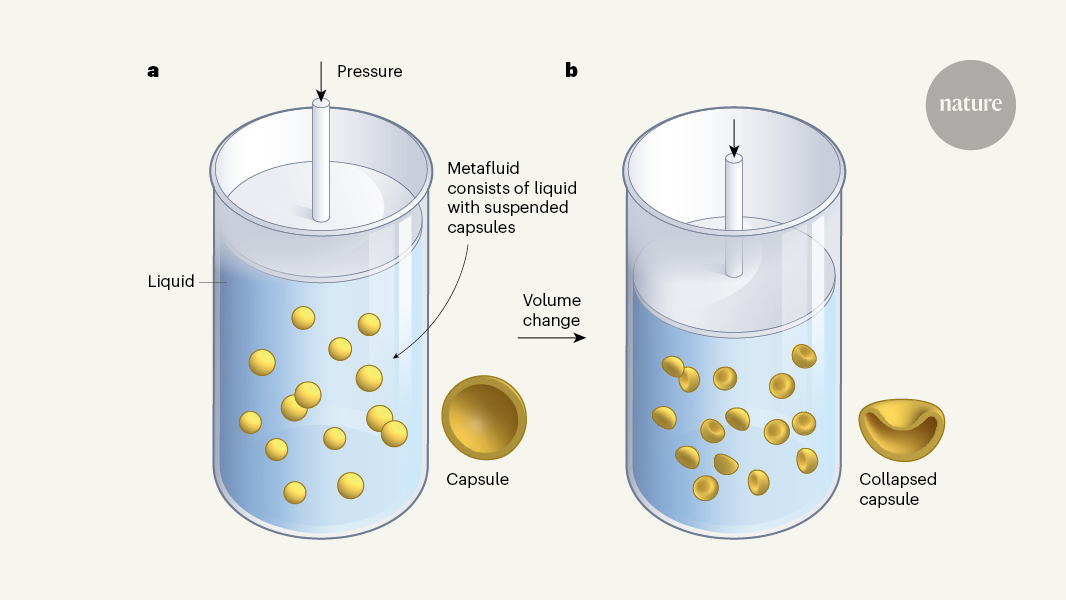Metafluid: A Hybrid Material Blending Liquid and Robotic Capabilities
Core Concepts
A newly developed "metafluid" material exhibits properties that challenge the traditional boundaries between solid, liquid, and gaseous states of matter.
Abstract
The article discusses the development of a novel "metafluid" material that exhibits properties that challenge the traditional distinctions between the three fundamental states of matter - solid, liquid, and gas.
The key highlights are:
Solids, liquids, and gases have well-established and distinct properties, such as compressibility and shape-conformity.
The researchers have developed a "metafluid" that blurs the lines between these traditional states of matter.
The metafluid displays intriguing properties that combine characteristics of both liquids and robotic systems.
This new material challenges the conventional understanding of the fundamental states of matter and opens up possibilities for innovative applications.
A quirky fluid that has robotic capabilities
Stats
No key metrics or figures provided in the content.
Quotes
No direct quotes provided in the content.
Key Insights Distilled From
by P.-T. Brun at www.nature.com 04-03-2024
https://www.nature.com/articles/d41586-024-00888-x
Deeper Inquiries
What specific properties and capabilities does the metafluid possess that challenge the traditional definitions of matter states?
The metafluid developed by Djellouli et al. challenges the traditional definitions of matter states by exhibiting properties that blur the lines between solids, liquids, and gases. Unlike conventional fluids, this metafluid has robotic capabilities, which means it can change its shape and behavior in response to external stimuli. This dynamic behavior goes beyond the static nature of solids, liquids, and gases, introducing a new level of adaptability and responsiveness that is not typically associated with traditional states of matter. Additionally, the metafluid's ability to exhibit properties of multiple states of matter simultaneously challenges the well-established distinctions between solids, liquids, and gases, opening up new possibilities for understanding and manipulating matter.
How might the development of metafluids impact our understanding of material science and lead to new applications?
The development of metafluids has the potential to revolutionize our understanding of material science by providing insights into the behavior of matter that go beyond the limitations of traditional states. By studying the properties and capabilities of metafluids, researchers can gain a deeper understanding of the underlying principles that govern the behavior of matter at the nanoscale. This knowledge can then be applied to the design and development of new materials with enhanced functionalities and performance characteristics. For example, metafluids could be used to create self-healing materials, adaptive structures, or advanced sensors that respond to changes in their environment. The unique properties of metafluids could also lead to breakthroughs in fields such as robotics, biotechnology, and nanotechnology, opening up new avenues for innovation and discovery.
What other unconventional or hybrid states of matter could be possible, and what implications might they have for our fundamental models of the physical world?
The development of metafluids suggests that other unconventional or hybrid states of matter could be possible, each with its own unique properties and capabilities. For example, researchers have explored the concept of "supersolids," which exhibit both solid-like and superfluid-like behavior. These supersolids challenge our traditional understanding of matter states by combining the rigidity of solids with the flow properties of superfluids. Other potential hybrid states of matter could include "quantum spin liquids," "topological insulators," or "quantum Hall fluids," each of which exhibits novel behaviors that defy conventional classifications.
The implications of discovering and studying these unconventional states of matter are profound, as they could lead to a paradigm shift in our fundamental models of the physical world. By expanding our understanding of the possible states of matter, we can gain new insights into the nature of reality at the quantum level and explore the boundaries of what is possible within the realm of material science. These discoveries could have far-reaching implications for technology, energy, and medicine, paving the way for new innovations and breakthroughs that were previously thought to be impossible.
0
